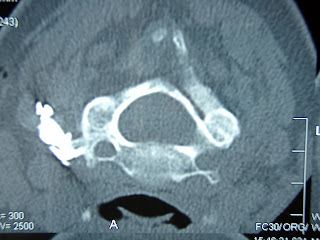This is a 34 y old woman with low back pain since several years for which no obvious cause was found on clinical examination and MRI. Pain developed shortly after a car accident and was confined to the right side of the lower lumbar region. The patient had undergone a 3 weeks period of intense multi-modal rehabilitation without any significant improvement of her pain. She was subjected to diagnostic medial branch blocks from L3 to L5 on the right side following a double blind, randomized protocol with 0.5% bupivacaine versus 2% lidocaine, administred at 0.5 cc per nerve level. 100% of pain disappeared after each block series and the duration of pain relief was compatible with the duration of action of the respective local anesthetic. She subsequently underwent radiofrequency neurotomy of the medial branches of L3 and L4 and the posterior branch of L5 on the right side as illustrated by the two following images.

Six parallel lesions were performed at the median part of the transverse processes of L4 and L5 in order to coagulate the medial branches of L3 and L4. The image shows the needles in their most lateral positions. The needles were directed from below with the electrodes lying parallel to the nerves. The projection is oblique from above looking down on the upper surface of the transverse processes.

Five parallel lesions were performed around the valley of the upper part of the sacrum where the L5 posterior ramus runs. The image shows the needle in its most median position 1/3 up on the superior articular process of the sacrum. Compared to the two other levels, the needle pass was less cranial. The projection is oblique, parallel to the L4/5 disc.
The patient had postoperative pain that was burning in character and associated with allodynia in the skin of the denervated segments lasting 3 weeks. During this period she noted that her usual back pain had completely disappeared. The postoperative pain then slowly disappeared over the next week.
6 weeks after the z-joint neurotomy she underwent an MRI of the pelvis for a completely different pain, known from before, that was presumed to be of gynecological origin. This pain was predominantly left sided. An ovarian cyst was found. In addition, the radiologist diagnosed edema in the lumbar paravetebral muscles comparable to what has been previously described in other muscle groups in the radiology literature. The muscular edema was situated on the treated side as seen on the following two images and in the region that is supplied by the muscular nerve branches coagulated with the z-joint branches.

Edematous infiltration of the latissimus muscle on the right side (T1 after gadolinium, coronal section).

Edema in the multifidus muscles on the treated side (T1 after gadolinium, coronal section).
The patient was back to us for her first control two months after the neurotomy. She reported a greater than 90% disappearance of her old low back pain. The clinical examination did not reveal any signs or symptoms associated with the edema seen on MRI. Thermal and light touch sensitivity were decreased in the initially allodynic territory.
The presence of MRI documented muscular edema associated with peripheral nerve injury is well described in the literature (see for instance Scalf RE, et al: MRI findings of 26 patients with Parsonage-Turner Syndrome; Am J Roentgenology 2007).
To our knowledge this is the first description of muscular edema after z-joint neurotomy, the clinical and functional significance of which remains unclear. We hypothesize it might be a muscular manifestation of CRPS, despite pain not being present any more.
















